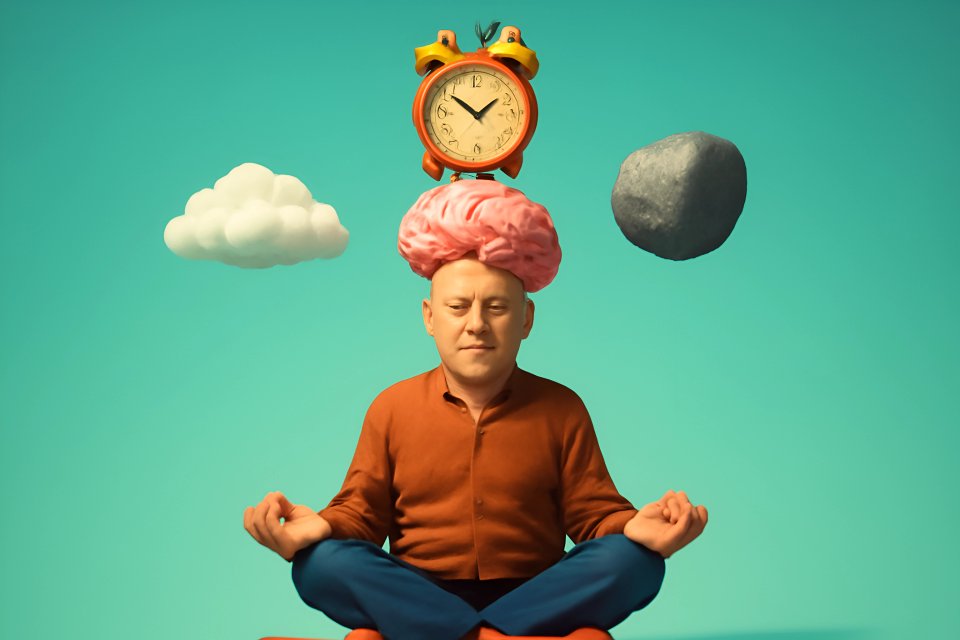
Does the phrase ‘a good night’s sleep’ feel like a distant, almost mythical memory? You are not alone. For so many of us navigating life after 50, the deep, restorative sleep we once took for granted can become frustratingly elusive, leaving us to face the day feeling tired, foggy, and a step behind.
It’s not just in your head. Our bodies naturally change, and as the Sleep Foundation notes, our internal clocks, or circadian rhythms, can shift, altering hormone production and sleep patterns. In fact, research from the CDC shows that over half of adults in our age group report significant sleep disturbances. But what if the key to reclaiming your rest isn’t a new mattress or a magic pill, but a gentle, powerful shift in your evening habits? This is the promise of a mindful evening routine for better sleep over 50—a simple yet profound way to calm your mind, soothe your body, and signal that it’s time for deep, healing rest.
In this guide, we will walk you through creating a personalized evening ritual that feels like a gift to yourself. We’ll explore calming stretches, simple meditation techniques, and other science-backed practices designed to help you quiet the noise of the day. Get ready to wake up feeling refreshed, clear-headed, and truly energized for the vibrant life you deserve.
The Mind-Body Connection: How a Busy Mind Disrupts Sleep
Have you ever laid your head on the pillow, only to have your brain switch into overdrive? This isn't a personal failing; it's a biological response. When we’re stressed, anxious, or replaying the day’s events, our bodies release cortisol and adrenaline, triggering the ancient "fight or flight" system designed for survival. This state of high alert is the exact opposite of what your body needs to surrender to sleep.
Mindfulness is the practice of gently paying attention to the present moment, without judgment. In the context of sleep, it means learning to quiet the endless ‘mental chatter’ that keeps you awake. A landmark study from UCLA found that older adults who practiced mindfulness meditation not only fell asleep faster but also experienced 30% fewer nighttime awakenings. It’s a direct intervention against the hyperarousal that sabotages our rest.
This practice is especially powerful for us after 50. This stage of life often comes with a unique set of worries—concerns about health, aging parents, financial security, or the transition into retirement. Mindfulness gives you the tools to acknowledge these thoughts without letting them hijack your nervous system, creating the mental peace necessary for your body to finally rest.
Your Step-by-Step Guide to a Soothing Pre-Sleep Ritual
Think of the following pillars not as a rigid checklist, but as a menu of options. The goal is to build a routine that feels nurturing and sustainable for you. Start by choosing one or two that resonate most deeply and build from there, creating a custom ritual that you genuinely look forward to each evening.
Pillar 1: The "Digital Sunset" - Unplug to Unwind
That seemingly harmless habit of scrolling on your phone or tablet in bed is one of the biggest modern-day sleep thieves. The blue light emitted from these screens directly interferes with your brain's production of melatonin, the crucial hormone that tells your body it's time to sleep. Studies show that evening exposure to this light can suppress total melatonin production by a staggering 23%, making it much harder to drift off.
The most powerful action you can take is to declare a tech curfew. Set an alarm for 60 to 90 minutes before your intended bedtime, and when it goes off, put all screens away for the night. This single act creates a clear boundary between the stimulation of the day and the calm of the evening, giving your brain the signal it needs to begin winding down.
What do you do with that newfound time? Rediscover the simple, analog pleasures. Pick up a physical book, listen to calming music, or tune into a relaxing podcast. These activities engage your mind without the melatonin-disrupting blue light, helping you transition gracefully toward sleep.
Pillar 2: Gentle Movement to Release Physical Tension
The aches, pains, and stiffness that accumulate throughout the day can make finding a comfortable sleeping position a real challenge. Gentle, restorative movement is a beautiful way to release that stored physical tension and ease your body into a state of relaxation. Research has shown that just 15 minutes of simple evening stretching can improve sleep efficiency by 18% for older adults by soothing the nervous system.
You don’t need to be a yoga master to benefit. Try incorporating a few of these simple, age-appropriate movements into your routine. A seated Cat-Cow stretch can release tension in your spine, while gentle neck rolls can ease strain in your shoulders. The Legs-Up-The-Wall pose is particularly wonderful for promoting circulation and deep relaxation. For more ideas, explore these effective recovery techniques for joint health and mobility after 50.
The most important tip is to listen to your body. These movements should feel restorative and soothing, never strenuous or painful. This is about communicating safety and comfort to your muscles and joints, preparing them for a night of deep rest and repair. If you're looking to incorporate more gentle activity into your life, our guide on how to build a low-impact exercise routine over 50 is a great place to start.
Pillar 3: Bedtime Meditation for a Quiet Mind (Perfect for Over 50s)
This pillar directly targets the "racing thoughts" problem that keeps so many of us staring at the ceiling. A dedicated bedtime meditation over 50 is one of the most effective ways to guide your mind from a state of frantic activity to one of serene calm. The goal isn't to stop your thoughts, but to gently shift your focus away from them.
You can start with a simple five-minute practice right in your bed. Try a simple body scan: bring your attention to your toes, then your feet, your legs, and so on, simply noticing the sensations without judgment. Or, focus on your breath with a simple mantra:
Breathe in calm, breathe out the day's worries.For those who want more guidance, our post on deep breathing and meditation techniques for stress management over 50 offers more detailed exercises.
While there are wonderful apps like Calm or Insight Timer, remember that you don't need any technology for this practice to be effective. In fact, practicing without a screen reinforces your "digital sunset." The power of meditation comes from within, and it’s a skill that, like any other, grows stronger and more effective with consistent, gentle practice.
Pillar 4: The Comfort of a Calming Beverage
A warm, comforting, non-caffeinated drink before bed is more than just a cozy habit; it’s a powerful psychological cue. This simple ritual acts as a trigger, signaling to your brain and body that the day is done and it's time to transition into a state of rest and relaxation. It’s a moment of self-care that bookends your day with warmth and tranquility.
Choose your beverage wisely for maximum benefit. Chamomile tea is a classic for a reason; it contains a compound called apigenin that binds to receptors in the brain that promote sleepiness. Lavender tea is another excellent choice, known for its ability to calm the nervous system.
A small cup of warm milk is another time-tested remedy. While the tryptophan connection is often debated, the combination of warmth, calcium, and the psychological comfort it provides can be incredibly effective. The key is to make this a mindful moment: sip slowly, savor the warmth, and let it be a symbol of you nurturing yourself.
Pillar 5: Journaling to Let Go of the Day
Do you find your mind clinging to to-do lists and unresolved worries as you try to sleep? Journaling provides a physical outlet for these thoughts, allowing you to "offload" them from your brain so they don't follow you to bed. A fascinating study found that individuals who spent just five minutes writing a specific to-do list for the next day fell asleep significantly faster than those who wrote about past events.
Keep a notebook by your bed and try these two simple prompts each night. First, practice gratitude by writing down three small things that went well today. This simple act shifts your focus from lack to abundance. Second, practice release by writing down one worry or task you can set aside until morning, creating what experts call cognitive closure.
This isn't about solving all your problems before you sleep. It's about giving your mind permission to let go. By transferring your worries onto the page, you are telling your brain, "This is handled. You can rest now." It’s a powerful act of mental hygiene that clears the way for peace.
Creating Your Sleep Sanctuary: Essential Sleep Hygiene for Seniors
Your bedroom environment plays a critical role in the quality of your sleep. By optimizing your space for rest, you reinforce the powerful message that this room is a haven for rejuvenation. These simple principles of sleep hygiene for seniors can make a world of difference in preventing unwanted awakenings.
First, focus on keeping your room cool, dark, and quiet. Experts recommend an ideal room temperature of around 65°F (18°C) to facilitate the natural drop in core body temperature needed for sleep. Use blackout curtains or a comfortable eye mask to block out all light, and consider earplugs or a white noise machine to mask disruptive sounds. For those dealing with more persistent sleep issues, our guide on advanced tips for overcoming insomnia in your 50s and beyond offers more in-depth solutions.
Next, engage your sense of smell. The scent of lavender has been consistently shown to promote relaxation and improve sleep quality. Using a simple essential oil diffuser or a lavender pillow spray can transform your bedroom into a calming oasis, creating an immediate sense of tranquility the moment you walk in.
Finally, reinforce the powerful mental association between your bed and rest. Make it a rule that your bed is reserved for sleep and intimacy only. Avoid working, eating, or watching television in bed. This strengthens the connection in your brain, so that simply getting into bed becomes a powerful trigger for sleepiness.
Your Journey to Better Sleep Starts Tonight
Reclaiming your rest is not about a single grand gesture, but about the small, consistent, mindful choices you make each evening. By creating a routine that includes unplugging from technology, releasing physical tension with gentle movement, quieting your mind with meditation, and creating a true sleep sanctuary, you are taking back control of your nights.
Building a new routine takes time, so be patient and compassionate with yourself. Start with just one or two practices from this guide that truly resonate with you and build from there. Remember, investing in your sleep is one of the most powerful and loving ways you can invest in your health, your energy, and your vitality for all the incredible years to come.
What's one mindful practice you're excited to try tonight? Share your choice in the comments below—let's support each other on this journey to more restful nights.
















